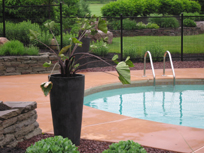Sharpening the Focus

 What are the issues that need to be considered in designing a new swimming pool? In two previous installments in this series, we first focused on the information-gathering process, and then on budgeting and setting expectations. In this third and final chapter, we’ll roll through what’s involved in defining a project’s scope and giving form to the void in a client’s backyard.
What are the issues that need to be considered in designing a new swimming pool? In two previous installments in this series, we first focused on the information-gathering process, and then on budgeting and setting expectations. In this third and final chapter, we’ll roll through what’s involved in defining a project’s scope and giving form to the void in a client’s backyard.
By this point, we as designers should know what our clients are after, whether it is a place for exercising, cooling off, socializing, therapy or children at play. We should know whether they want shaded areas, swim-up bars or outdoor kitchens. And we should know their approximate financial tolerance.
So now we start getting specific. What artists or architects inspire them? Have they traveled and enjoyed a resort pool or a friend’s pool that they particularly admire? Have they (as I’ve requested) spent time with magazines and on the Web finding projects they like? What shapes do they like? What turns them on? What turns them off?
It’s also time to consider the setting – the architecture of the home as well as the nature of the pool’s physical surroundings. Does the space call for something formal or informal? Should the pool be curvaceous, linear or a combination? Exactly where should it be placed?
Armed with answers to all of these questions and much more besides, we should be ready to deliver the outcome our clients desire.
A Practical Overlay
Atop all of these coalescing details, we as professionals also need to consider a raft of practicalities.
We need, for example, to consider local codes and to be mindful of details such as setback requirements (and whether it’s possible to get variances to overcome them); site access; soils issues (especially in new developments that have been subjected to extensive grading, cutting and filling); buried utilities and access to service; a range of considerations related to easements, water-conservation mandates; and a range of other issues that can and do arise in the course of building a pool.
Moreover, if you operate only as a designer, you need to be as specific and detailed as possible in developing construction specifications – and it helps if you are on good terms with the contractors who will actually install the pool. In all cases, you need to make it clear to the installer that you are working in the interests of the clients and that differences of opinion between you should be dealt with behind the scenes. (The client is paying for the final product and should not need to be subjected to arguments or any other actions that might shed unfavorable or compromising light on the final outcome.)
On the flip side, my clients know all about where I stand and know exactly what I’ll do to support their interests. I explain to them that I will design the pool and present them with a general concept for review. If they’re curious, I can offer them a ballpark figure for the ultimate cost, subject to refinement once contractors become involved.
I also make it a practice to screen and prequalify these clients to make certain I won’t be wasting any contractor’s time as the project develops. I work with a small group of pool installers, some specializing in gunite installations, others with expertise with vinyl-liner pools. Our choice among these builders extends directly from budget projections and the clients’ desires. Once the clients commit, I bring in my pool contractors to help finalize the design, work through technical issues and project the cost. This way, they are involved and do not feel as though they’re just “quoting a pool.”
Finally, I also make it very clear to both my clients and the installer that I am not a middle man: The homeowners and the installer have a separate contract. But this doesn’t mean I wash my hands and stay away; instead, everyone knows I will be observing all phases of the installation, particularly the layout and elevations. But I also respect the installer’s role and try not to look over anyone’s shoulder, so my visits are occasional and involve not much more than making certain we’re all still on the same page.
Once the main pool-installation work is done, we return to the site because, in most cases, we do the finish work and take care of installing copings, decks, paved areas and the rest of the surrounding landscape. As a result, we are very careful that the pool installer follows the intent of the design and involves us in resolving any issues related to elevations, tile design, equipment placement and so forth.
As I see it, the resulting swimming pool will be part of my clients’ lives for many years to come. With proper planning, design and installation, we can all be assured of a positive outcome – after which we can step aside and let the fun begin!
Bruce Zaretsky is president of Zaretsky and Associates, a landscape design/construction/consultation company in Rochester, N.Y. You can reach him at [email protected].









